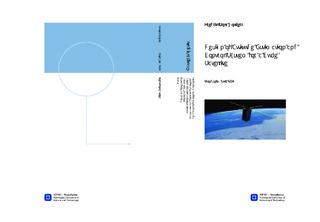| dc.contributor.advisor | Gravdahl, Jan Tommy | nb_NO |
| dc.contributor.advisor | Grøtli, Esten | nb_NO |
| dc.contributor.author | Holberg, Fredrik Sola | nb_NO |
| dc.date.accessioned | 2014-12-19T14:06:27Z | |
| dc.date.available | 2014-12-19T14:06:27Z | |
| dc.date.created | 2012-11-11 | nb_NO |
| dc.date.issued | 2012 | nb_NO |
| dc.identifier | 567051 | nb_NO |
| dc.identifier | ntnudaim:6842 | nb_NO |
| dc.identifier.uri | http://hdl.handle.net/11250/260763 | |
| dc.description.abstract | Abstract The NUTS (NTNU Test Satellite) is a satellite being built in a student CubeSat project at the Norwegian University of Science and Technology. The project was started in September 2010 as a part of the Norwegian student satellite program run by NAROM (Norwegian Centre for Space-related Education). The NUTS project goals are to design, manufacture and launch a double CubeSat by 2014. As payload an IR-camera observing waves in the air-glow layer is planned, as well as a short-range RF experiment. The satellite will fly two transceivers in the amateur radio bands. Final year master students from several departments are the main contributors in the project and most of the system components are designed and built by students.Abstract Described in this paper is an assesement of different strategies for selecting and designing the Attitude Determination and Control System, ADCS, for the NUTS satellite, effectively providing the next iteration from the work that was conducted last year, placing much emphasis on the special requirements of a system that can not be repaired or maintained in a traditional way.Abstract Different options for sensors and actuators are explored and evaluated, looking for tried and tested products with a low chance of failure and concluding that Analog devices should be a safe and reliable provider of the inertial measurement units for our satellite.Abstract While the Extended Kalman Filter is the filtering method that is probably the most used in almost all applications, it has some very serious limitations that are especially important in such a demanding environment as a cube satellite. Two other methods for attitude estimation are evaluated, namely the Extended QUaternion ESTimator and newly developed nonlinear observers. While they both are very attractive options with many properties that fit with our requirements, there are still some questions as to wether they are as reliable as the proven EKF or not.Abstract The open source electronic prototyping platform Arduino is gaining foothold with hobbyists all over the world, and it is explored if it can also be used for rapid prototyping and if it is suitable for frequent design iterations in our satellite project. The freedom it provides coupled with a standard breadboard seems to make it a very good choice for any project needing to frequently change or improve it's design according to other hardware or software considerations. | nb_NO |
| dc.language | eng | nb_NO |
| dc.publisher | Institutt for teknisk kybernetikk | nb_NO |
| dc.subject | ntnudaim:6842 | no_NO |
| dc.subject | MTTK teknisk kybernetikk | no_NO |
| dc.title | Design of Attitude Estimation and Control System for a Cube Satellite | nb_NO |
| dc.type | Master thesis | nb_NO |
| dc.source.pagenumber | 67 | nb_NO |
| dc.contributor.department | Norges teknisk-naturvitenskapelige universitet, Fakultet for informasjonsteknologi, matematikk og elektroteknikk, Institutt for teknisk kybernetikk | nb_NO |

